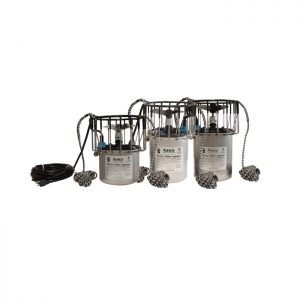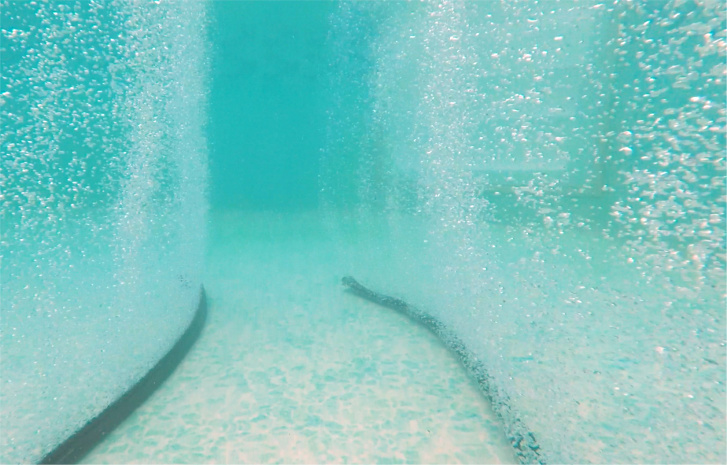Deicing
We have unsurpassed expertise in commercial and industrial deicing projects
Each deicing technology we use will give varying results, depending on the circumstances of the project and objectives of our clients. With our expertise, we can help you select the optimal system for your project, keeping in mind such factors as cost, time, seasonal variations, wind, ice thickness, depth, safety, power availability and power consumption.
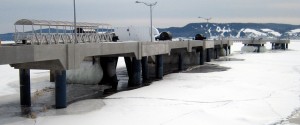
Being well informed about deicing options and how to safely install and maintain your deicer system is important. We are known globally for our unique expertise in the field of deicing. With projects in the high Arctic, Antarctica, the United States, and throughout Canada*, we use our vast experience to consult with you on your particular application. We determine what the optimal method is, then assist with a custom design, and provide all necessary support for your project.
* Alberta, Ontario, Quebec, Nova Scotia, New Brunswick, Saskatchewan, Manitoba, British Columbia and the Maritimes
What is deicing?
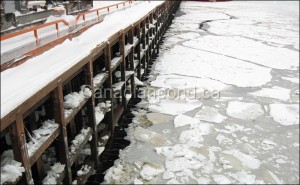
Deicing is the use of various technologies to prevent ice formation in salt or fresh water. Ice build-up prevention is critical for protecting boat houses, commercial and residential docks, marine structures, ferry crossings, floating pumps, working barges and municipal pumping stations. These technologies are known as bubblers, Thawline, ice eaters, thrusters, submerged diffusers and ice melting aeration by some industries. Different deicing technologies will prevent ice build-up by using various methods. Thawline and OctoAir deicers use the physics of moving warmer and heavier water from the bottom to the surface via micro air diffusion. This lifts water and creates a current on the surface where ice cannot form.
Comparatively, impeller deicing uses continuous movement on the water surface to prevent surface ice formation. Impellers will be less efficient compared to deeper diffusers using aeration melting process, but on the other hand will work fine where existing river currents prevent water stratification.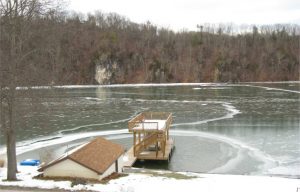
Deicing involves using knowledge of water physics and the amalgamation of the principles of gravity combined with water temperature and depth. Water is at its heaviest at 4 degrees Celsius and at its lightest at zero degrees Celsius, so in practice that explains why ice floats. In a lake situation where no water current exists, the heavier and warmer water will be at the bottom. Lifting this heavier water is achieved with the friction of bubbles rising in synergy towards the surface. The width of deicing efficiency will be influenced by the air flow, the depth and the outside temperature affecting ice growth. Our three deicing technologies will give different results depending on the circumstances of each projects. Our team of experts will help you select the optimal system for you by taking into account costs, seasonal variations, wind, ice thickness and security concerns.
Types of Ice Damage
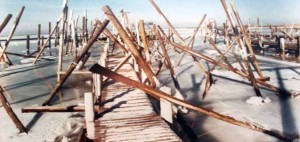
Property or shoreline damage from winter ice can be predicted with previous knowledge of lake morphology and geography. The most common types of ice damage are: ice sheet expansion (pressure), ice jacking (water level fluctuation), ice flow movement during spring melt, which typically can push large sheets of ice on shore and create massive damage, or ice formation created by tidal activity. Often a combination of these forces can complicate and limit industrial activities.
Ice Sheet Expansion is a common phenomenon that is observed as pressure ridges on large lakes. Pressure ridges are a natural occurrence often seen in the same region on a lake every year. When ice forms and thickens it also expands. Typically, ice expands its volume by about 9% when it goes from liquid to solid. The expansion process is slow and steady so by late winter property is being damaged by this ongoing process. Ice sheet expansion is what traps boats and structures and creates pressure damage.

Ice Jacking is well described in this video. Ice jacking happens when the ice grips onto structures and lifts or shifts them as water levels fluctuate. Many lake and reservoir water levels are known to fluctuate, so structural damage to posts, piles or dock structures from Ice Jacking is to be expected unless a de-icing system is used.
Ice Flow Damage is also known as ice shove, ice surge, ice heave or shoreline ice pileup. This condition is created when the ice sheet melts around the lake perimeter in spring, allowing strong winds to move the ice sheet onto shore. This phenomenon is quite common in fresh and salt water. A dramatic instance of ice flow damage can be seen on this clip from Dauphin Lake Manitoba near Winnipeg. Ice flow damage can occur in association with pressure ridge formation, particularly in lakes that freeze late in winter or lakes that only partially freeze.
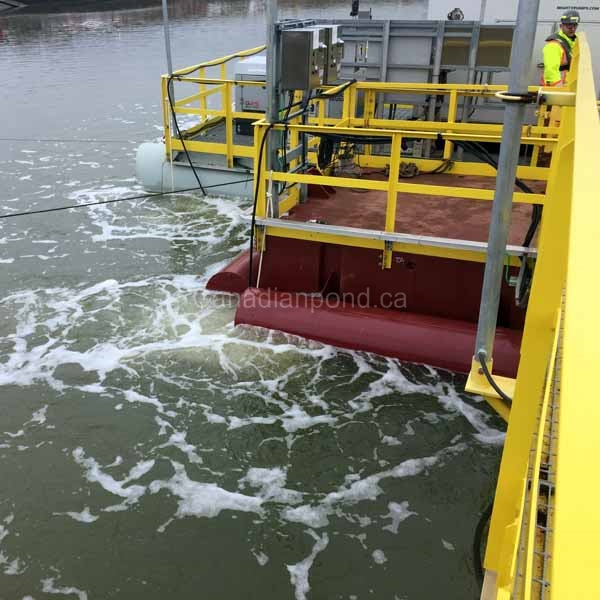 Ice build-up from Tidal Action. Ice build-up from tidal action and ocean currents can make loading and unloading at industrial ports very challenging if not dangerous. This kind of ice buildup can shut down operations in northern sea-going ports affected by strong tides. With proper planning and design, an ocean port affected by tidal ice buildup can be operational later in the fall and earlier in the spring when a custom Thawline Bubbler is employed. In some instances, sea-going ports may be kept operating all winter.
Ice build-up from Tidal Action. Ice build-up from tidal action and ocean currents can make loading and unloading at industrial ports very challenging if not dangerous. This kind of ice buildup can shut down operations in northern sea-going ports affected by strong tides. With proper planning and design, an ocean port affected by tidal ice buildup can be operational later in the fall and earlier in the spring when a custom Thawline Bubbler is employed. In some instances, sea-going ports may be kept operating all winter.
Ice Jam in Rivers and Canals. Ice jam events happen rapidly when a rise in temperature or rainfall triggers the break up and accumulation of fragmented river ice, usually in the same place every year. Ice jams and associated flooding in winter and spring can be more damaging than open water flood events. Every province in Canada experiences this kind of flooding and damage. Extreme measures such as blasting (a technique used in Ottawa along the Rideau Canal) can cause structural property damage over time, not to mention harm to aquatic communities.
Northern Passage Deicing. In theory, our techniques and know-how could be used to maintain a shipping lane open in extreme conditions such as those found in the high Canadian Arctic. In extreme conditions, all types of ice damage could be at play. Concerns over ice damage or overcoming ice as a limit to development, are challenges awaiting our expertise.
Deicing Solutions
We recommend deicing solutions unique to each application. No deicing project is the same. In our process, we take into account water depths, the size of deicing area required, the type of structure to protect, the location, various temperatures, power limitation and other environmental factors. Many systems are custom designed according to site requirements and budget.
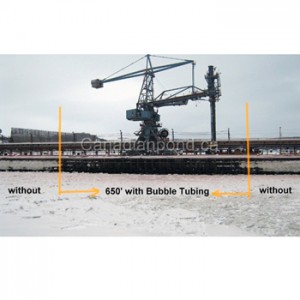
Simple systems such as the Thawline Bubbler Deicers use a compressor on shore that feeds air to the basin floor, bringing slightly warmer water up to the surface. This creates a small current to assist in maintaining an ice-free zone. In extreme cold conditions a fragile and weak layer of ice may form. Fragile and thin layers of ice will not damage the structures. Some clients expect a huge swath of open water near their docs, but that is a waste of energy and it can be dangerous to lake users. The Thawline systems are used mainly:
- To break pressure and reduce damage from ice sheet expansion.
- To reduce ice buildup from tidal action when laid parallel to marine structures.
- For linear openings, such as ferry lanes.
- At marinas and around pilings to eliminate ice jacking.
- In rivers and canals to prevent ice jams.
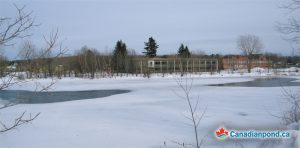 OctoAir Industrial Diffusers operate on the same principle as the Thawline Deicers. However, rather than deice in a line, the OctoAir creates a much larger circular opening. The size of the opening varies with ambient temperature fluctuations. Here are a few applications for these diffusers:
OctoAir Industrial Diffusers operate on the same principle as the Thawline Deicers. However, rather than deice in a line, the OctoAir creates a much larger circular opening. The size of the opening varies with ambient temperature fluctuations. Here are a few applications for these diffusers:
- A series of OctoAir tamper ice flow damage along sensitive shorelines
- For deep deicing applications, such as water intake pipes, ferry terminals
- Strategically located to prevent ice jamming at hydro-electric stations or along rivers
- To keep pumping stations and industrial barges protected
- To assist working crews doing structural repairs in winter on bridges or dams.
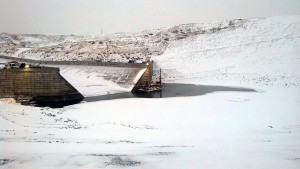
Kasco Marine Impeller Deicers continuously move surface water to prevent ice formation. They can be:
- Suspended in the water by mooring ropes to reduce damage from ice jacking in marinas
- Attached to a dock by mounts, allowing circular or oval openings, depending on the angle of the de-icer.
- They can be installed so they are not affected by tidal movements.
- They are recommended in river settings where specific water movements are sought.
- They are used at ski hills to keep open water for snow making equipment.
A discussion with our experts will give you a better idea about which system is best suited for your particular application.
The following chart is a General overview of deicer options. For large installations that require several lines of tubing or many OctoAir diffusers sometimes even a combination of all of them, consult us directly. Items such as Cost or Power consumption vary widely based on the size of the system and its components. Width of ice opening can also be modeled and used for planning.
Deicing Technologies Comparison Chart
This Deicing Technologies Comparison Chart will help you determine the optimal deicing system for a particular application taking into account many important factors. Simply download the chart to read it!
Recommended Maintenance Chart for Deicers
This Recommended Maintenance Chart for Deicers will help you manage maintenance for your deicing system.

